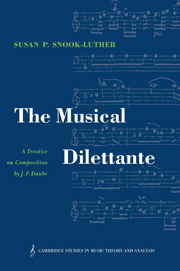Book contents
- Frontmatter
- Contents
- Foreword
- Translator's preface
- Introduction
- THE MUSICAL DILETTANTE: A TREATISE ON COMPOSITION (1773)
- Preface
- 1 Harmony in general
- 2 The three different motions of the voices
- 3 Combining two voices
- 4 Combining three voices
- 5 Combining four voices
- 6 Composition in five and more parts
- 7 Variation
- 8 Imitation
- 9 Canon
- 10 Simple fugue
- 11 Double counterpoint
- 12 Double fugue
- Bibliography
- Index
5 - Combining four voices
Published online by Cambridge University Press: 15 October 2009
- Frontmatter
- Contents
- Foreword
- Translator's preface
- Introduction
- THE MUSICAL DILETTANTE: A TREATISE ON COMPOSITION (1773)
- Preface
- 1 Harmony in general
- 2 The three different motions of the voices
- 3 Combining two voices
- 4 Combining three voices
- 5 Combining four voices
- 6 Composition in five and more parts
- 7 Variation
- 8 Imitation
- 9 Canon
- 10 Simple fugue
- 11 Double counterpoint
- 12 Double fugue
- Bibliography
- Index
Summary
This discussion is based on the preceding one. All that was explained there can be applied here. Indeed, one can almost say that four-part composition is the easiest of all, in so far as the four voices do not concert among themselves, but rather are to be regarded as four simple voices. What is essential here is the knowledge of the three chords, of their order, of the three motions, of the retardation, and of the relationship of the keys. All this and much more is to be observed in an artificial two- or three-part piece. But [in natural four-part writing] the main concern is simply to distribute the voices well, taking special care that the two outer voices, namely the upper voice and the bass, carry no irregular harmony (the inner voices can tolerate fifths and octaves more readily), and that the other two voices remain in their proper position. The viola in particular should be kept in its appointed place, where it sometimes appears as a middle voice and sometimes as a higher bass. Furthermore, care is to be taken that this voice may never ascend above the first voice and thereby alter the main melody. And since it is tuned in unison with the violins, it is quite easy, in view of the preceding, to understand why it should not rise above the first voice. We have found these mistakes even in the scores of skilled people.
- Type
- Chapter
- Information
- The Musical DilettanteA Treatise on Composition by J. F. Daube, pp. 104 - 119Publisher: Cambridge University PressPrint publication year: 1992



